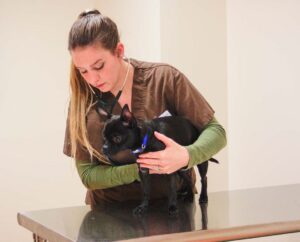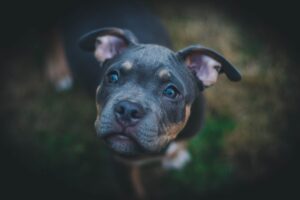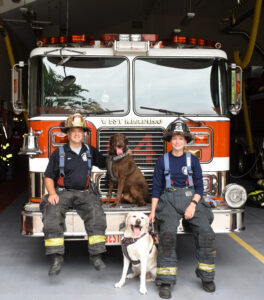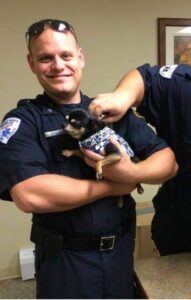By: Leann Quire, Director of Shelter Operations for Humane Pennsylvania
If you ever had a pet go missing, for any length of time, you know how terrifying and stressful it can be.
 The fear of never seeing them again sets in immediately. Or if they end up hours away – how will someone get in contact with you? What if they’re hurt and need help?
The fear of never seeing them again sets in immediately. Or if they end up hours away – how will someone get in contact with you? What if they’re hurt and need help?
The thoughts, concerns, and anxieties can go on and on until your beloved pet is back in your care, safe and sound.
July is National Pet Loss Prevention Month, which is intended to bring awareness to the many animals that go missing every year. Animals are family – and they deserve to stay safe in their homes, by their owner’s side.
To help ensure your animals remain safe by your side, we are going to discuss some helpful pet loss prevention tips.
Microchip
What is a microchip? A microchip is a tiny radio-frequency identifier that is inserted under your pet’s skin, typically between the shoulder blades.
The chip has a unique identification number that appears when it’s scanned with an appropriate device (typically found at shelters and veterinary hospitals). Some police officers even carry microchip scanners now so they can immediately scan stray animals to see if they can get them back to their owners quickly.
If your dog or cat is not already microchipped, talk to your veterinarian about setting up an appointment. Many shelters and rescue groups hold vaccine and microchip clinics, some of which you don’t even need an appointment to attend.
Throughout the year, Humane Pennsylvania offers pay-what-you-can vaccine and microchip clinics. You can find upcoming dates by going to humanepa.org.
Register and update the chip! Many people who have had their pet microchipped make the mistake of not keeping their information updated or even checking to make sure their pet’s microchip is registered. Contact your microchip company regularly to update addresses, phone numbers, and alternate contacts.
Not sure if your pet is microchipped? Many shelters and veterinarians will scan your pet at no cost. Call those in your local area to find one that can help.
Once you receive a microchip number, you can use AAHA’s microchip lookup at https://www.petmicrochiplookup.org/ to determine whether the microchipped is registered, what company your pet’s chip is registered through, and how you can update necessary info. You can also find out how to get your pet’s chip registered if it isn’t already.
Report a Lost or Found Animal
If you find a lost pet, there are some important things you should do to play your part in helping that animal get back to its owner.
- Check with neighbors to see if anyone recognizes the pet.
- Take the animal to a local shelter or veterinary hospital to get scanned for a microchip.
- Call your local shelter to complete a found report or to see if they have any lost reports that match the description of the pet you found.
- Post to Facebook groups and websites created for helping owners find their lost pets.
- If you are unable to keep the pet safe while you try to find the owner, call the municipality where you found the pet and see who they contract with to advise you on where to take the pet to safely stay while the owner is located.
Spay and Neuter
Spay and neuter isn’t just important for controlling the pet population; it can also prevent animals from going astray. Intact males are highly driven to roam and find a mate, so they are more likely to find ways out of the home.
Supervise
Don’t leave your pets unsupervised. Even in a fenced yard or enclosure, you should always be with your pet in case they find a faulty fence post, are a master digger, or have perfected the art of fence climbing.
Collars, Harnesses, and Leashes
Make sure your dog wears an appropriate fitted collar or harness. You don’t want to find out the hard way that the collar was too big and your beloved pet slipped out of it while trying to chase a bicycle or squirrel.
Use the “two-finger” rule to check for a proper fit by sliding two fingers between your dog’s neck and collar to make sure the collar is not too snug or too loose. You should not be able to pull the collar up and over the dog’s head.
 Remember that dogs grow, lose weight, and gain weight just like people do, so it is important to frequently check how your dog’s collar fits and also that it is in good condition.
Remember that dogs grow, lose weight, and gain weight just like people do, so it is important to frequently check how your dog’s collar fits and also that it is in good condition.
Harnesses are also great options for smaller breeds and brachycephalic breeds (short nose dogs like pugs and bulldogs) with delicate windpipes. Harnesses can discourage pulling, provide you with better control, and prevent injury to the neck area.
There are many different kinds of harnesses, so do your research or work with a professional to identify which harness is best for you and your dog.
Retractable leashes are generally not safe and are not recommended. Retractable style leashes provide little control and often extend very far, which can be dangerous if you and your dog are walking near roads or encounter other animals that are not pet-friendly.
Additionally, the cord used in these leashes is not durable and can snap or easily tangle around the walker or dog and cause serious injury.
Talk to your veterinarian or trainer before making the decision to purchase a retractable leash.
Proper Identification
Not only should your pet have properly fitted collars and harnesses, but they should also have proper identification if they happen to get loose.
An identification tag with your pet’s name, along with your phone number and city, can increase the chances of you reuniting with your pet.
Having your pet’s current rabies tag, license tag, microchip tag, and identification tag on their collar is beneficial and increases the chance of your furry friend getting back home.
We hope you never have to experience the terrible stress of having a pet go missing, but hopefully, following these tips will result in a quick, healthy, and happy reunion!


 their business partner with us for a fundraiser. It’s so lovely to see people really embrace our mission and have an understanding of what Humane Pennsylvania is all about.
their business partner with us for a fundraiser. It’s so lovely to see people really embrace our mission and have an understanding of what Humane Pennsylvania is all about. hazard because dogs, cats, mice, bunnies will sometimes chew on them. Unattended lit candles are not only dangerous on their own but can be easily knocked over by pets.
hazard because dogs, cats, mice, bunnies will sometimes chew on them. Unattended lit candles are not only dangerous on their own but can be easily knocked over by pets. A.G.: If you can’t get them out, DO NOT go back in to get them. Let the arriving responders know the last known location and a description of the animal.
A.G.: If you can’t get them out, DO NOT go back in to get them. Let the arriving responders know the last known location and a description of the animal.